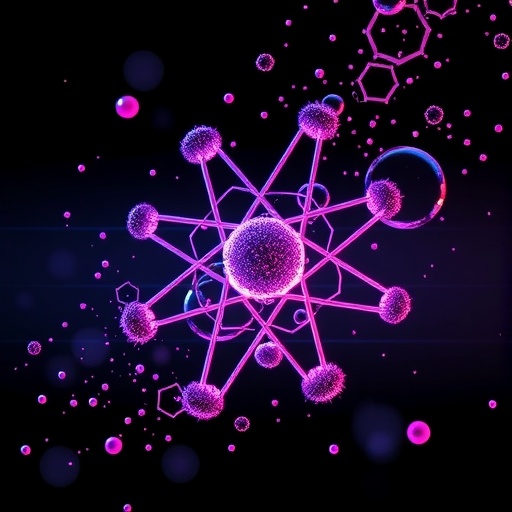In a groundbreaking advancement at the crossroads of nanotechnology and materials science, researchers have unveiled a novel method for fabricating patchy nanoparticles (NPs) with unprecedented nanoscale precision. This technique, termed atomic stencilling, leverages the selective adsorption of adatoms to create intricate molecular masks on nanoparticle surfaces. The result is a versatile library of patchy NPs, promising to revolutionize the design of nanoscale materials with tailored surface chemistry.
At the heart of this breakthrough lies a robust multiscale theoretical framework that integrates cutting-edge computational and experimental methodologies. Combining density functional theory (DFT) calculations with polymer scaling theory, molecular dynamics (MD) simulations of polymer chain configurations, and Monte Carlo (MC) simulations of large-scale NP assembly, researchers successfully predict and corroborate experimental outcomes. This synergy between theory, simulation, and experiment forms a powerful toolkit that can be readily extended to a wide array of nanoparticle systems.
One of the most compelling aspects of the atomic stencilling approach is its broad applicability to diverse nanoparticle compositions, shapes, and sizes. Researchers highlight gold nanorods as particularly promising candidates for future exploration due to their complex faceting behaviors influenced by particle dimension and synthesis conditions. Beyond gold, the method shows significant potential for other metals such as palladium, copper, and silver, where facet-selective adsorption principles can be harnessed to produce similarly patterned structures.
In their experiments, the team demonstrated that iodide ions serve as effective adatoms, selectively adsorbing onto specific crystallographic facets of metal nanoparticles. Palladium nanocubes, for instance, exhibited face-patched morphologies similar to those observed with gold nanocubes upon iodide treatment. While the detailed co-adsorption mechanisms involving 2-naphthalenethiol (2-NAT) require further elucidation, these findings open new avenues to tailor NP surfaces through atomic-scale chemical modulation.
Surface chemistry plays a pivotal role in dictating nanoparticle properties fundamental to a breadth of applications. Control over nanoparticle surface features influences self-assembly behaviors, electron–photon interactions, charge and electron transfer efficiencies, and catalytic reactivity. Atomic stencilling ushers in a new paradigm where such surface chemistry can be precisely engineered at the nanometer scale, accelerating advances across fields ranging from metamaterials and quantum information science to fuel cells, batteries, and catalysis.
One of the most exciting implications of precise nanoscale patterning is its impact on the engineering of three-dimensional (3D) superlattices. By leveraging directional surface ligand patches on nanoparticles, the research group achieved nanoscale control over colloidal “valency,” a concept correlating to the number and geometry of interaction sites. This represents a significant leap beyond isotropic DNA-grafted nanoparticles, enabling directional bonding motifs that may diverge from underlying particle symmetry and open new design spaces for complex and functional nanostructured materials.
Valency-controlled assembly has been extensively studied in molecular systems such as metal–organic frameworks and micrometer-scale colloids, where it contributes to innovations in reticular chemistry, catalysis, and dynamic, out-of-equilibrium structures. Translating such control down to the nanoparticle scale has been challenging, but atomic stencilling provides a robust platform to achieve this with spatial precision previously unattainable, promising new insights into self-assembly pathways and emergent nanoscale architectures.
To visualize and understand the assembly dynamics dictated by these engineered directional interactions, the researchers employed advanced in situ techniques including liquid-phase transmission electron microscopy (TEM) and small-angle X-ray scattering (SAXS). These approaches offer temporal and spatial resolution sufficient to unravel how patchy nanoparticle interactions govern nucleation, growth, and kinetic trapping within superlattices, factors critical for tailoring material properties.
Beyond fundamental science, the implications for technological applications are profound. The capacity to pattern surfaces at nanometer resolution enables the development of integrated circuits and multifunctional materials with enhanced performance and novel functionalities. Moreover, the robust chemical selectivity imparted by atomic stencilling presents opportunities to improve selectivity and efficiency in catalysis, energy conversion devices, and membrane separation technologies.
The ability to modulate surface chemistry with atomic-scale precision also holds tremendous promise for the design of quantum information systems. Nanoparticles interfaced through well-defined, directional ligand patches could serve as building blocks for quantum metamaterials with tunable optical and electronic properties, potentially facilitating breakthroughs in coherent quantum control and photonic devices.
This pioneering work not only underscores the critical role of surface chemistry engineering in nanoscale science but also demonstrates the power of integrating theoretical predictions with sophisticated experimental methods. The multiscale approach bridging electronic structure calculations and polymer physics paves the way for rational design strategies of functional nanoparticle systems customized for specific applications.
Looking forward, the versatility and tunability of atomic stencilling could catalyze a paradigm shift in nanoparticle synthesis and assembly, enabling the creation of hierarchically structured materials tailored at scales from atomic to macroscopic. Its extension to various metal systems and morphologies promises rich scientific discovery and a wide spectrum of technological innovations.
In summary, atomic stencilling embodies a transformative advance in nanofabrication, enabling precise, facet-selective molecular patterning that controls nanoparticle valency and surface chemistry. This method seamlessly merges theory, simulation, and experiment to unlock new frontiers in the design of nanomaterials, with far-reaching implications across chemistry, physics, and materials engineering disciplines.
Subject of Research: Precision engineering of nanoparticle surface chemistry through atomic stencilling enabling nanoscale patch patterning and directional interactions for advanced materials assembly.
Article Title: Patchy nanoparticles by atomic stencilling.
Article References:
Kim, A., Kim, C., Waltmann, T. et al. Patchy nanoparticles by atomic stencilling. Nature 646, 592–600 (2025). https://doi.org/10.1038/s41586-025-09605-8
Image Credits: AI Generated
DOI: https://doi.org/10.1038/s41586-025-09605-8
Keywords: atomic stencilling, patchy nanoparticles, nanoparticle surface chemistry, facet-selective adsorption, multiscale simulation, nanoparticle valency, nanoscale self-assembly, directional interactions, polymer grafting, gold nanorods, palladium nanocubes, nanofabrication




